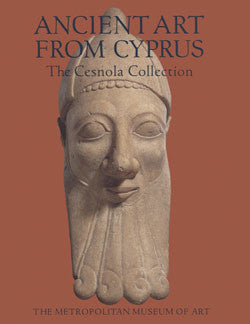Ancient Art from Cyprus, The Cesnola Collection
50,00 $
ISBN: 0-8109-6552-6
Description: hardcover, 400 pp. (28x22,5cm), phots, figs.
Condition: new
Weight: 1790g.
Vassos Karageorghis, Ancient Art from Cyprus, The Cesnola Collection in The Metropolitan Museum of Art, Metropolitan Museum of Art, 2000
The Cesnola Collection in The Metropolitan Museum of Art is the richest and most varied representation, outside Cyprus, of Cypriot antiquities. These works were purchased by the newly established Museum in the mid-1870s from General Luigi Palma di Cesnola, a Civil War cavalry officer who had amassed the objects while serving as the American consul on Cyprus. The Cesnola Collection was the earliest acquisition of Mediterranean antiquities by the Museum and constituted its primary display of archaeological material. In 1879 Cesnola became the Museum's first director, a position that he held until his death in 1904.
This splendid catalogue is published on the occasion of the opening of the Museum's four permanent galleries for ancient art from Cyprus. It is also the first scholarly publication since 1914 devoted to the Cesnola Collection (which totals approximately six thousand objects). The volume features some five hundred pieces from the collection, illustrated in superb new color photography. Dating from about 2500 B.C. to about A.D. 300, these works rank among the finest examples of Cypriot art from the prehistoric, Geometric, Archaic, Classical, Hellenistic, and Roman periods. Among the objects are monumental sculpture; weapons, tools, and domestic utensils; vases, lamps, and ritual paraphernalia; dedicatory figurines; engraved sealstones and jewelry; and luxury objects. They represent every major medium worked in antiquity—stone, copper-based metal, clay, faience, glass, gold and silver, ivory, and semiprecious stones. These pieces testify to the quintessentially Cypriot amalgam of indigenous traditions and elements assimilated from the ancient Assyrians, Egyptians, Persians, Greeks, and Romans who, one after the other, controlled the island. Special emphasis is placed on the Metropolitan Museum's collection of Cypriot limestone sculpture, which includes impressive sarcophagi from Golgoi and Amathus and is the finest in the world.
Vassos Karageorghis is the former Director of the Department of Antiquities of the Republic of Cyprus.
Joan R. Mertens is Curator in the Department of Greek and Roman Art at The Metropolitan Museum of Art.
Marice E. Rose is Research Associate in the Department of Greek and Roman Art at The Metropolitan Museum of Art.
Director's Foreword
Preface
Acknowledgments
Contributors to the Catalogue
Note to the Reader
Chronology
Maps
Introduction
I. The Prehistoric Period (ca. 10,000–1050 B.C.)
Coroplastic (Terracotta) Art
Pottery
Copper-Based Metalwork
Faience
Cylinder Seals
Ivory and Bone Objects
Jewelry
Stone Vases
II. The Cypro-Geometric and Cypro-Archaic Periods (ca. 1050–480 B.C.)
Pottery
Stone Sculpture
Coroplastic (Terracotta) Art
Metalwork
Luxury Utensils
Jewelry
III. The Cypro-Classical Period (ca. 480–310 B.C.)
Stone Sculpture
Coroplastic (Terracotta) Art
Bronze and Iron Objects
Stone and Glass Vases
Jewelry and Gems
IV. The Hellenistic and Roman Periods (ca. 310 B.C.–A.D. 330)
Stone Sculpture
Coroplastic (Terracotta) Art
Pottery
Bronze and Iron Objects
Glass
Lamps
Jewelry and Gems
Bibliography of Works Cited
Description: hardcover, 400 pp. (28x22,5cm), phots, figs.
Condition: new
Weight: 1790g.
Vassos Karageorghis, Ancient Art from Cyprus, The Cesnola Collection in The Metropolitan Museum of Art, Metropolitan Museum of Art, 2000
The Cesnola Collection in The Metropolitan Museum of Art is the richest and most varied representation, outside Cyprus, of Cypriot antiquities. These works were purchased by the newly established Museum in the mid-1870s from General Luigi Palma di Cesnola, a Civil War cavalry officer who had amassed the objects while serving as the American consul on Cyprus. The Cesnola Collection was the earliest acquisition of Mediterranean antiquities by the Museum and constituted its primary display of archaeological material. In 1879 Cesnola became the Museum's first director, a position that he held until his death in 1904.
This splendid catalogue is published on the occasion of the opening of the Museum's four permanent galleries for ancient art from Cyprus. It is also the first scholarly publication since 1914 devoted to the Cesnola Collection (which totals approximately six thousand objects). The volume features some five hundred pieces from the collection, illustrated in superb new color photography. Dating from about 2500 B.C. to about A.D. 300, these works rank among the finest examples of Cypriot art from the prehistoric, Geometric, Archaic, Classical, Hellenistic, and Roman periods. Among the objects are monumental sculpture; weapons, tools, and domestic utensils; vases, lamps, and ritual paraphernalia; dedicatory figurines; engraved sealstones and jewelry; and luxury objects. They represent every major medium worked in antiquity—stone, copper-based metal, clay, faience, glass, gold and silver, ivory, and semiprecious stones. These pieces testify to the quintessentially Cypriot amalgam of indigenous traditions and elements assimilated from the ancient Assyrians, Egyptians, Persians, Greeks, and Romans who, one after the other, controlled the island. Special emphasis is placed on the Metropolitan Museum's collection of Cypriot limestone sculpture, which includes impressive sarcophagi from Golgoi and Amathus and is the finest in the world.
Vassos Karageorghis is the former Director of the Department of Antiquities of the Republic of Cyprus.
Joan R. Mertens is Curator in the Department of Greek and Roman Art at The Metropolitan Museum of Art.
Marice E. Rose is Research Associate in the Department of Greek and Roman Art at The Metropolitan Museum of Art.
Director's Foreword
Preface
Acknowledgments
Contributors to the Catalogue
Note to the Reader
Chronology
Maps
Introduction
I. The Prehistoric Period (ca. 10,000–1050 B.C.)
Coroplastic (Terracotta) Art
Pottery
Copper-Based Metalwork
Faience
Cylinder Seals
Ivory and Bone Objects
Jewelry
Stone Vases
II. The Cypro-Geometric and Cypro-Archaic Periods (ca. 1050–480 B.C.)
Pottery
Stone Sculpture
Coroplastic (Terracotta) Art
Metalwork
Luxury Utensils
Jewelry
III. The Cypro-Classical Period (ca. 480–310 B.C.)
Stone Sculpture
Coroplastic (Terracotta) Art
Bronze and Iron Objects
Stone and Glass Vases
Jewelry and Gems
IV. The Hellenistic and Roman Periods (ca. 310 B.C.–A.D. 330)
Stone Sculpture
Coroplastic (Terracotta) Art
Pottery
Bronze and Iron Objects
Glass
Lamps
Jewelry and Gems
Bibliography of Works Cited





